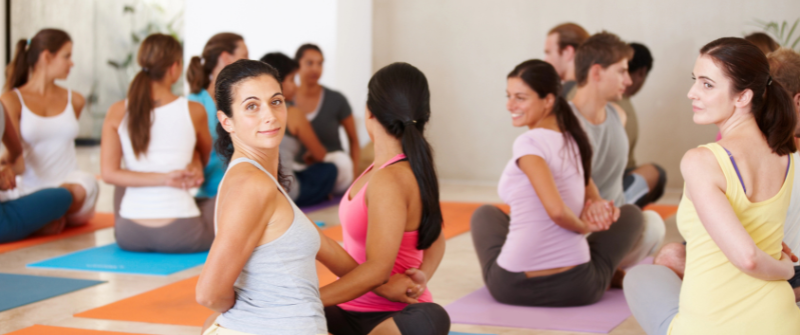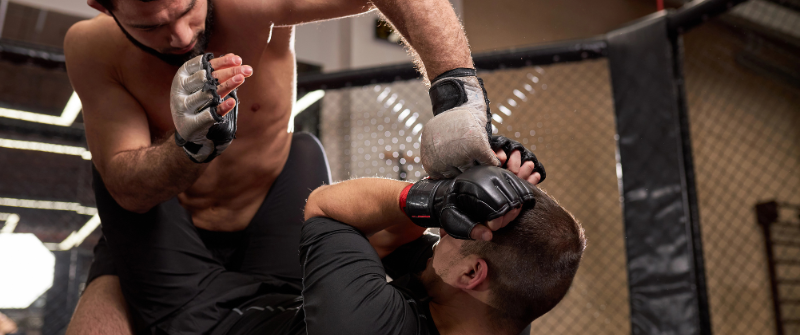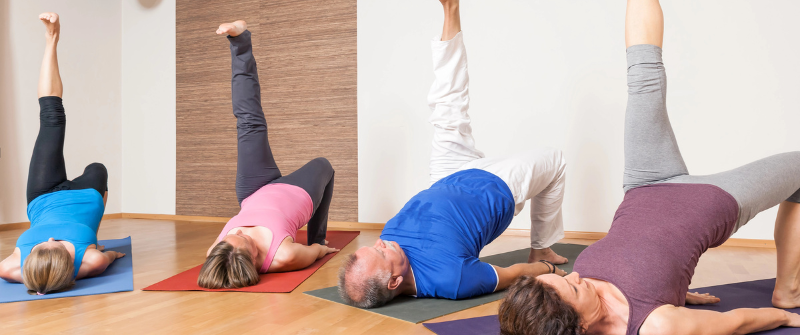
- by NEXO Team
- January 7, 2025
As yoga continues to grow in popularity, studio owners and instructors need to balance prioritizing their students’ safety while also maintaining the practice's therapeutic benefits. Yoga studios have to deal with a wide variety of potential risks on a daily basis, ranging from students pushing too hard in poses to basic studio safety concerns. All of these issues could affect both practitioners and instructors alike.
When proper safety guidelines and staff training are set in place, studios are able to create an environment where students can focus on their practice without worry. Taking these keeps everyone safe while also building trust with clients, which is something that is incredibly important for any yoga studio's success.
Understanding Risks in Yoga Studios
Yoga studios need to be aware of several major risks that could potentially impact their students and business. Here's what to watch for:
- Physical injuries happen when students push themselves beyond their limits or receive improper guidance in poses. Some common issues include lower back strains, wrist injuries during weight-bearing poses, and knee problems from misaligned postures.
- Environmental hazards often stem from basic maintenance oversights. For example, humid conditions could make floors dangerously slippery, while worn-out props or mats can fail during use.
- Health emergencies might arise unexpectedly, especially in hot yoga classes. These range from mild dehydration to more serious conditions like dizziness or breathing difficulties.
- Emotional safety matters just as much as physical health. In a yoga studio, students may feel pressured to attempt advanced poses, or experience discomfort from inappropriate adjustments or comments.
- Legal issues typically stem from injuries or incidents that could have been prevented in the first place. Just one serious accident could damage both a studio's reputation and their financial stability.
Also Read: Insurance for Yoga Studio Events: Coverage and Considerations
Essential Safety Protocols
The best yoga studios make safety their top priority. These protocols should be set in place to protect students and create a secure practice environment:
Facility Safety
The studio space itself needs regular safety checks. This includes maintaining slip-resistant floors, having proper ventilation, and securing all equipment. Good lighting is also important, particularly around stairs and transitions between spaces. Additionally, emergency exits should always be clearly marked and easily accessible.
Health and Hygiene
Maintaining good hygiene in a yoga studio means regular deep cleaning and attention to detail. Sanitize high-touch surfaces throughout the day, stock cleaning supplies in convenient spots, and ask students to bring their own mats. These small steps all add up to create a healthy practice space.
Emergency Preparedness
Every studio needs a clear plan for handling emergencies. This means having first aid supplies readily available, posted evacuation routes, and updated emergency contacts for all regular students. Quick response times matter during emergencies, so all staff members should know exactly what to do in case of any medical situation.
Class Structure and Management
Good class management starts with setting appropriate size limits, keeping props tidy and well-organized, and giving students plenty of space to safely flow through their practice.
Also Read: How to Handle Accidents and Injuries in Your Yoga Studio: Insurance Insights
Training Measures for Staff and Instructors
To create a strong teaching team, studios need to invest in training that goes well beyond the basics. These are the main areas to address:
Certification and Qualifications
All instructors should hold recognized yoga certifications and have solid knowledge of anatomy and injury prevention. Studios should also support their staff in pursuing additional training to deepen their expertise, whether that's specialized certificates in prenatal yoga or workshops on trauma-informed teaching methods.
First Aid and CPR Training
Medical emergencies could happen anywhere, so every staff member needs to have current first aid and CPR certification, with regular refresher courses to keep these skills sharp. Having this basic medical training will help staff members respond quickly and appropriately when they need to.
Injury Prevention Techniques
 Teachers need to know how to guide students safely through their practice. This includes leading effective warmups, offering modifications for all skill levels, and being able to recognize when students are struggling or pushing themselves too hard. Clear demos and hands-on adjustments should always prioritize safety over depth.
Teachers need to know how to guide students safely through their practice. This includes leading effective warmups, offering modifications for all skill levels, and being able to recognize when students are struggling or pushing themselves too hard. Clear demos and hands-on adjustments should always prioritize safety over depth.
Communication and Conflict Management
Strong communication skills help prevent many problems before they even start. All staff members should learn how to give clear instructions, offer constructive feedback, and handle difficult situations with both professionalism and care.
Creating a Culture of Safety
While solid rules and protocols are an important aspect of building a safe yoga studio, it’s just as important for everyone to play their part in creating a secure practice environment. This is achieved through:
Client Education
New students need to have a solid foundation, starting with clear guidelines about class expectations and studio protocols. Encourage students to share any injuries or health concerns that they may have, and teach them how to recognize their body's signals during practice. A proper orientation that’s mandatory for all students and staff will also help prevent many common issues before they arise.
Inclusivity and Accessibility
Every body is different, and classes need to reflect this. When students feel comfortable asking for modifications, they're more likely to practice safely and within their limits, so it’s important to create an environment where everyone feels welcome, regardless of their experience or physical ability. Teachers should also offer plenty of pose variations and keep props readily available.
Feedback Mechanisms
Students are often the first ones to notice safety concerns, so studio owners should provide easy ways for them to share feedback, whether through comment cards, regular surveys, or direct conversations with staff. Take all safety suggestions seriously and act on them promptly. When students see that their input matters, they become active partners in keeping the studio safe.
Monitoring and Continuous Improvement
Keeping a yoga studio safe requires regular check-ins and updates to make sure everything is running smoothly. Here's how to stay on track:
Regular Safety Audits
Schedule monthly walk-throughs to inspect all of the equipment, check out the studio conditions, and verify that safety protocols are being followed. If there are any issues that need attention, be sure to document them and address them in a timely manner.
Staff Performance Reviews
Keep an open dialogue with instructors about their teaching style and safety practices. Regular check-ins offer a chance to share feedback about their class management and chat about opportunities for additional training.
Staying Updated on Industry Best Practices
To keep up with changes happening in the yoga world, it’s a good idea to attend industry workshops, connect with other studio owners, and keep up with the latest safety recommendations. Getting fresh perspectives tends to lead to valuable improvements in studio safety.
Also Read: How to Ensure Your Club or Studio Meets Insurance Requirements and Regulations
Conclusion
The best yoga studios weave safety into everything they do. When studios commit to strong safety practices and comprehensive staff training, they create an environment where their students feel confident in exploring their practice. This dedication to safety naturally builds trust and helps the studio grow.
If you’re ready to take your studio's protection to the next level, NEXO specializes in yoga studio insurance, with coverage packages designed to match your specific needs. Contact us today to learn more!
Categories
Fill out a short form to contact us with your questions or to receive a customized quote.
Recent Posts
-
 NEXO’s Affinity Program: How Fitness Suppliers and Associations Can Partner for Profit and Protection
December 5, 2025
NEXO’s Affinity Program: How Fitness Suppliers and Associations Can Partner for Profit and Protection
December 5, 2025 -
%20(1).png) How to Insure an MMA Gym Without Paying for Coverage You Don’t Need
December 5, 2025
How to Insure an MMA Gym Without Paying for Coverage You Don’t Need
December 5, 2025 -
 Mastering Liability for Jiu-Jitsu Tournaments and Martial Arts Events
December 5, 2025
Mastering Liability for Jiu-Jitsu Tournaments and Martial Arts Events
December 5, 2025 -
 From Zen to Zoning: What Every Yoga and Pilates Studio Owner Should Know Before Signing a Lease
December 5, 2025
From Zen to Zoning: What Every Yoga and Pilates Studio Owner Should Know Before Signing a Lease
December 5, 2025 -
%20(1).png) Why Your Referral & Loyalty Program Can Impact Your Insurance Rates
December 5, 2025
Why Your Referral & Loyalty Program Can Impact Your Insurance Rates
December 5, 2025
